Hats
- Dressing Your Head
According to the encyclopedia, the definition of “hat” is a covering for the head consisting of a crown and a brim. Simple, right? It goes on to say that people wear hats for three reasons; 1 – protection, 2- communication, and 3 – decoration. In the driving world, one can easily cite an example of each. We see helmets in combined driving and immediately connect to the marathon phase and protection. When we see a top hat worn by a driver, it communicates a formal look just as a cap communicates an informal look. Bows and feathers on a ladies hat serve as decorations drawing a pleasing picture to the eye. Still pretty simple.
So why do so 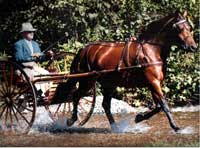 many
drivers worry so much over their hats? What seems simple on paper does not
prove simple in application. Not every hat looks good on every person (that’s
why there are so many hats out there!) and when you add to the picture a horse
and carriage, it gets more complicated. So, let’s try to simplify the
hat issue as much as we can.
many
drivers worry so much over their hats? What seems simple on paper does not
prove simple in application. Not every hat looks good on every person (that’s
why there are so many hats out there!) and when you add to the picture a horse
and carriage, it gets more complicated. So, let’s try to simplify the
hat issue as much as we can.
I like the example that the encyclopedia uses in that hats are a form of communication.
They tell something about the person wearing the hat. If you are driving a
sharp stepping horse to a formal vehicle, like a spider phaeton or Stanhope
gig, you are “showing off” your stuff. Would you prefer to look
just as sharp as you think your horse looks? Of course! So you are going to
pick a hat that “shows off” also. A top hat or a ladies hat with
a veil or expensive looking feathers or trim would suit. A wool cap or ladies
straw hat with a few ribbons would not. But they would be perfect for a nice
moving horse in a utilitarian type carriage such as a runabout or Meadowbrook
If you think of a hat as a form of self-expression it will be easier to select
one that projects the image you want. We live in an era where hats are more
utilitarian than fashion, but 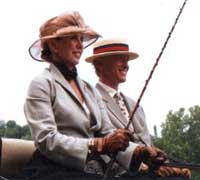 take
a look back in history and hats played a big role in expressing social status.
Certain “rules” dictated what you could or could not get away
with, although as with any fashion, those rules were constantly tested. An
example of this is wearing straw hats from Memorial Day to Labor Day and felt
hats the rest of the year. Even Tom Ryder thought this a bit ridiculous and
suggested that it would be more prudent to wear a hat that compliments the
weather.
take
a look back in history and hats played a big role in expressing social status.
Certain “rules” dictated what you could or could not get away
with, although as with any fashion, those rules were constantly tested. An
example of this is wearing straw hats from Memorial Day to Labor Day and felt
hats the rest of the year. Even Tom Ryder thought this a bit ridiculous and
suggested that it would be more prudent to wear a hat that compliments the
weather.
Ladies hats have been subjected to fashion changes more than men’s hats.
When the carriage driving revival began here in the 1960’s, the most
visual trendsetter for hats was our first lady, Jacqueline Kennedy. She wore
those little pillbox hats (the formal ones had veils) and so followed the
lady carriage drivers. Then came the big floppy hats of the 1970’s that
offered little comfort to a lady driving a carriage on a windy day, but she
wore them anyway.
In England, the Tilbury hat still remains quite popular with women despite
its uncanny resemblance to a man’s fedora. The Queen didn’t help
hat fashion much until Princess Di came along and offered the public some
color and style for their hats.
Just as fashion controlled the types of hats worn over the decades, the carriage
you drive controls what type of hat you should wear at a driving event. Just
as you would have chosen a hat to go with your outfit then, you need to choose
a hat that goes with both your outfit and your carriage. That hat is going
to communicate an image, whether it is formal, tailored, stylish or casual.
The first “rule” is to not out-dress your vehicle. A top hat is
associated with a tuxedo or 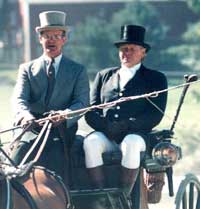 formal
suit, not a sports coat. In the same way it is associated with a formal vehicle,
not a Meadowbrook or road cart. Ladies hats are a bit trickier (and so they
have been through history!) but a veil definitely communicates a formal look.
formal
suit, not a sports coat. In the same way it is associated with a formal vehicle,
not a Meadowbrook or road cart. Ladies hats are a bit trickier (and so they
have been through history!) but a veil definitely communicates a formal look.
The second “rule” is to be sure the hat looks good on you. Some
men can pu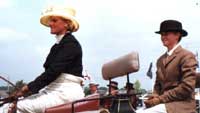 ll
off a bowler, some cannot. Some women can wear big hats, some cannot. Find
a TRUTHFUL friend and spend some time at a hat shop or at one of the wonderful
hat vendors found at many carriage events. Keep in mind that you are trying
to communicate a certain look
ll
off a bowler, some cannot. Some women can wear big hats, some cannot. Find
a TRUTHFUL friend and spend some time at a hat shop or at one of the wonderful
hat vendors found at many carriage events. Keep in mind that you are trying
to communicate a certain look
The third “rule is to keep that look in balance with your horse and
carriage. Take care that the color of the hat does not clash with the carriage,
or your horse, and that it does not overpower the outfit you plan to wear.
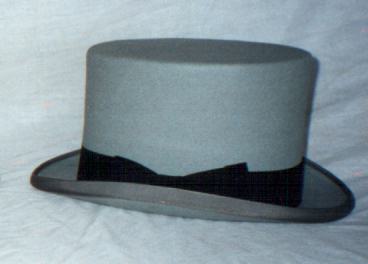
For men, this is much easier but there are still quite a few choices. In the
formal category; top hat (black or gray) or bowler (black, gray or brown).
Color will depend on the individual, but care should be taken to see what
works best with the vehicle, i.e., a brown bowler with a natural wood vehicle.
Informal; Bowler (bl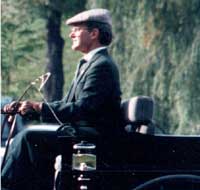 ack,
gray or brown), fedora (any solid color, felt or straw), straw boater, cap
(solid or tweed). The straw boater is
ack,
gray or brown), fedora (any solid color, felt or straw), straw boater, cap
(solid or tweed). The straw boater is ![]() perhaps
the most versatile of these hats as it goes with just about anything as long
as it is warm weather. These are fun hats and by changing the hatband to match
a jacket or lap robe, can add a lot to a turnout. There is nothing wrong with
Western hats if the turnout calls for it. With the exception of the fedora
and boater, all of these hats are appropriate for grooms, both male and female.
Keep in mind that the groom’s hats should not outdo the drivers!
perhaps
the most versatile of these hats as it goes with just about anything as long
as it is warm weather. These are fun hats and by changing the hatband to match
a jacket or lap robe, can add a lot to a turnout. There is nothing wrong with
Western hats if the turnout calls for it. With the exception of the fedora
and boater, all of these hats are appropriate for grooms, both male and female.
Keep in mind that the groom’s hats should not outdo the drivers!
Ladies can have a much wider choice of hats, which can be fun but also makes
the decision harder. Keep in mind that the hat is a form of communication.
The most formal  class
a lady could present herself in would be an evening class with a park drag.
Interestingly enough, no hat should be worn! During the day, however, just
about any style of hat is acceptable on a formal vehicle however it should
reflect the time of year and the purpose of the drive, i.e., a straw hat with
ribbons for an afternoon cross country class and a hat with a veil for a turn-out
class.
class
a lady could present herself in would be an evening class with a park drag.
Interestingly enough, no hat should be worn! During the day, however, just
about any style of hat is acceptable on a formal vehicle however it should
reflect the time of year and the purpose of the drive, i.e., a straw hat with
ribbons for an afternoon cross country class and a hat with a veil for a turn-out
class.
If you are drivi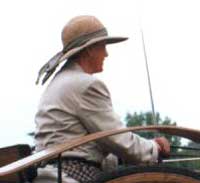 ng
a vehicle less formal than a park drag or Stanhope gig, just about anything
goes although I would suggest not wearing a veil. If you want a
ng
a vehicle less formal than a park drag or Stanhope gig, just about anything
goes although I would suggest not wearing a veil. If you want a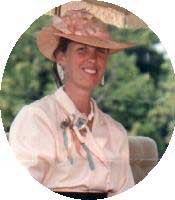 tailored look, an English Tilbury or small brimmed straw hat is ideal. If
you want to look stylish, spend some time looking for that “great”
hat that makes you look ten years younger and dressed to kill (and pray it
doesn’t clash with your carriage!). For a casual, but fun look, try
straw hats with ribbons and flowers that compliment your outfit and carriage.
tailored look, an English Tilbury or small brimmed straw hat is ideal. If
you want to look stylish, spend some time looking for that “great”
hat that makes you look ten years younger and dressed to kill (and pray it
doesn’t clash with your carriage!). For a casual, but fun look, try
straw hats with ribbons and flowers that compliment your outfit and carriage.
Since ladies hats ma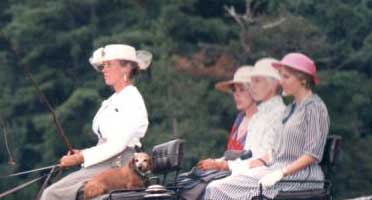 ke
such a “statement”, it is doubly important to choose complimentary
hats when two ladies are in the carriage. First, you don’t want the
hats fighting for space and second, you want the driver to stand out more
than the passenger. If the passenger is a gentleman, the same concept should
be kept in mind.
ke
such a “statement”, it is doubly important to choose complimentary
hats when two ladies are in the carriage. First, you don’t want the
hats fighting for space and second, you want the driver to stand out more
than the passenger. If the passenger is a gentleman, the same concept should
be kept in mind.
Since the hat is also a form of protection for the head, remember that rain and winds are no strangers to driving events. A large brimmed hat on a windy day is no fun. A soggy hat is not pretty. Shop for an inexpensive water-resistant hat that can be put into service with your raingear and yet still offer a bit of style.
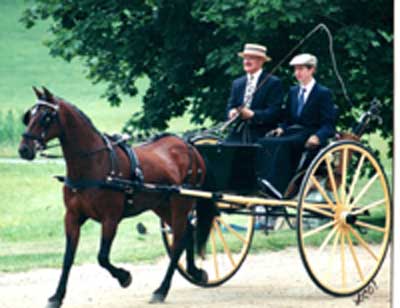
Selecting just the right hat can be more difficult than mastering a one handed
circle! A hat can make or break the impression you give to the judge, and
other competitors, as well as determine the comfort level of you day. There
are rules and written guidelines and unwritten guidelines to help select the
right hat, but the bottom line is whether it “works” or not.
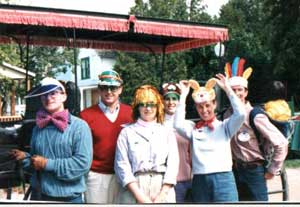
Never pass up an opportunity to have fun with hats!